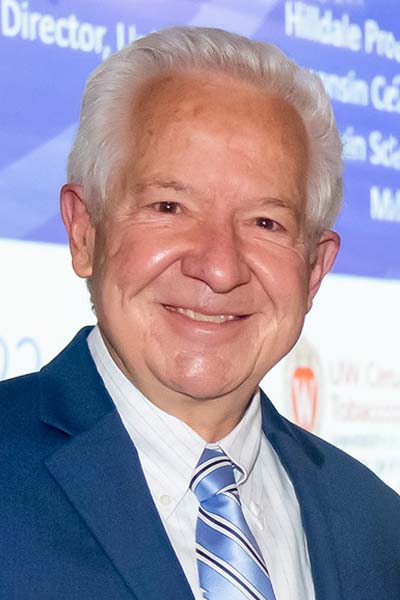The doctor responsible for ensuring that physicians began routinely recording the smoking histories of their patients in the 1990s laid out the history of health research on cigarette smoking and a plan to put an end to all tobacco use during the Keynote Series session on Tuesday, May 17.

Michael C. Fiore, MD, MPH, MBA, Hilldale Professor of Medicine at the University of Wisconsin, and founder and director of the UW Center for Tobacco Research and Intervention, began his presentation by pointing out that the historic U.S. Surgeon General report on the deadliness of smoking cigarettes came out in 1964.
“So, you may ask, ‘Why are we still talking about cigarettes in 2022?’” he said. “I want to make the case this morning that cigarette smoking continues to be the foremost public health challenge of our time. That as clinicians and scientists, we have a responsibility to both treat it and to study it.”
Tobacco use has declined dramatically in America from the mid-1950s, when about 43 percent of all adults smoked, to the most recent data from 2020, when just over 12 percent of adults smoked, he noted. If the current trajectory of decline continues on pace, Dr. Fiore noted, it will take until 2050 to eliminate tobacco use.
“Our challenge is to bend that curve,” he said.
About 30 million Americans smoke today. They are primarily concentrated in the poor and less-educated segments of society, and those with comorbid, mental health, and addictive disorders, Dr. Fiore said. There are also racial and ethnic minority groups that continue to smoke at higher rates, including Native Americans.
Each year, half a million Americans die from cigarette-related illnesses, representing 20 percent of all U.S. deaths. Of those, 75 percent are from diseases of the thoracic cavity. And about 10 to 15 percent of all health care costs — about $300 billion — annually go toward treating tobacco-related illnesses.
According to Dr. Fiore, physicians can help change those numbers and contribute to the elimination of tobacco use altogether.
Studies show that 70 percent of smokers want to quit and about half of them try to do so each year, he said. Yet only about half of smokers report that their health care provider is urging them to quit, and only about a third receive counseling or medication. The result: only about 5 percent of the smokers who try to quit each year get the recommended treatments.
“We’ve got to do better clinically,” Dr. Fiore said.
The U.S. Public Health Service has produced three guidelines over the last two decades that outline which treatments work and how to integrate them into clinical settings.
“I make the case that brief clinical advice matters, prescribing medications matters, and changing the architecture of your clinical settings so that every smoker is identified and you have a system in place that ensures that a single smoker does not leave the encounter without the help she or he needs to quit,” he said.
As chair of the Public Health Service clinical practice guideline panel for treating tobacco use and dependence, Dr. Fiore was asked to help update those recommendations. The powerful combination of counseling and nicotine replacement therapy was the No. 1 suggestion, as it results in a 70 percent boost in long-term cessation rates, he said.
For NRT, he recommends a patch to deliver round-the-clock nicotine and lozenges, which are rapidly absorbed and can blunt cravings. As for counseling patients who smoke, he said it can be as easy as referring them to the toll-free help line (800-QUIT-NOW), which connects people to live counselors and free NRT. Dr. Fiore said it’s even worth recommending NRT to patients who aren’t ready to quit, as studies have shown that it helps decrease their smoking and often eventually leads to quitting.
The introduction of e-cigarettes in recent years has been a double-edged sword, according to Dr. Fiore. They’re bad because they can be an enticement for teens to start smoking but good because they can be less harmful for adults who have been long-time smokers.
Even though there needs to be more research done on e-cigarettes, Dr. Fiore said ingesting nicotine through e-cigarettes might be preferable to smoking cigarettes because the combustion of tobacco is what causes lung diseases including cancer.
He also discussed the politics of smoking cessation rates in the U.S. The Obama administration (2009-2017) saw three times more smokers quit than the Clinton administration (1993-2001). Dr. Fiore attributes this to increasing the taxes on cigarettes by $1 a pack, which he called incredibly powerful, as well as stronger smoke-free policies, graphic media campaigns that showed the sometimes gruesome ravages that smoking caused in long-time cigarette users, and passage of the Affordable Care Act, which mandates that insurance companies pay for cessation treatment.
The U.S. Food and Drug Administration was also given authority to regulate tobacco products, and Dr. Fiore advocates that the FDA require the removal of nicotine from tobacco products. The FDA is considering prohibiting menthol in cigarettes and flavors in cigars.
Dr. Fiore ended his presentation by comparing the eradication of polio to the elimination of the use of tobacco.
“Little did we know that virtually at the same moment that we were confronting polio, an even greater threat was on the horizon,” he said. “A threat that will ultimately kill 20 million Americans, a threat that continues today.”
Extend Your Learning Beyond San Francisco with ATS 2025 Conference Highlights

With so many valuable educational opportunities offered during the ATS 2025 International Conference, attendees are often forced to decide which sessions to prioritize. That’s why the Society is offering three ATS 2025 Conference Highlights packages for those unable to attend ATS 2025 San Francisco or attendees interested in continuing their education after the conference. Check out the packages and pick the one that’s right for you. Learn at your own pace, whenever and wherever you are!

